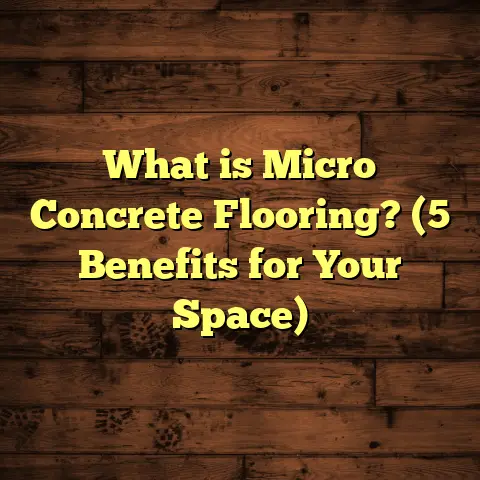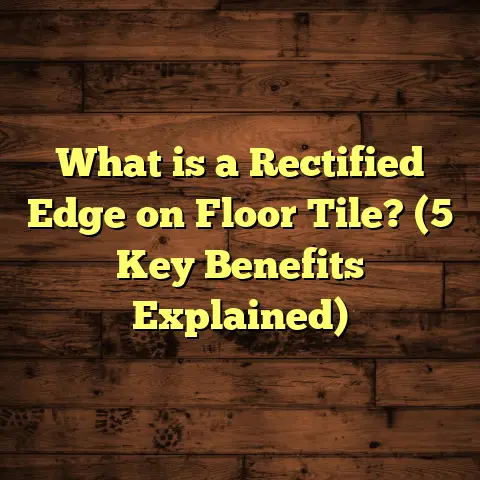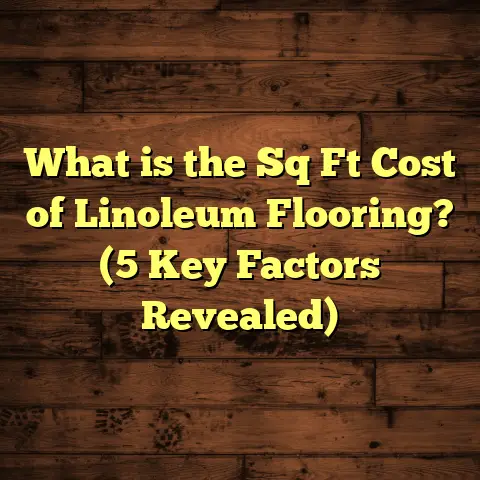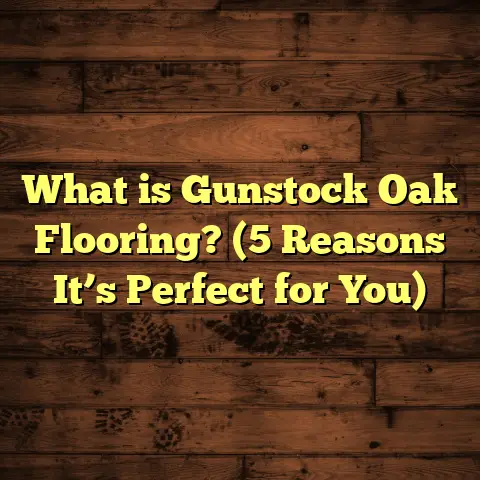What is the Difference Between Laminate and Vinyl Flooring? (5 Key Features Revealed)
I want to share something that could save you a lot of time and hassle if you’re thinking about updating your floors. When I first started working with clients on flooring projects, a question I heard over and over was: “Should I go with laminate or vinyl flooring?”
It’s a solid question because both options can look great and fit different budgets. But the truth is, they’re quite different once you get into the details—stuff that really matters when you live with your floors every day.
So, let’s get into it. I’ll walk you through what makes laminate and vinyl flooring unique by focusing on five key features that really set them apart. Along the way, I’ll share some stories from my own experiences and data that helped me understand which flooring works best in different situations.
What’s the Story Behind Laminate and Vinyl Flooring?
Before jumping into the nitty-gritty, let’s clarify what we’re actually talking about when we say laminate and vinyl flooring. Think of these two as distant cousins in the flooring family—both synthetic, but made differently, with distinct benefits and drawbacks.
Laminate Flooring — The Wood Lookalike
Laminate flooring is made by fusing multiple layers together.
The core is usually high-density fiberboard (HDF), topped with a photographic layer that mimics real wood, stone, or other textures. Then there’s a clear protective wear layer to keep it durable.
What I love about laminate is how realistic it can look without the price tag of real hardwood. And it’s pretty resilient, especially in areas where you don’t expect a ton of moisture.
But here’s one thing many people don’t realize: the quality of laminate can vary widely. From cheap stuff that peels or scratches easily to premium products with thick wear layers and detailed imaging. As a contractor, I’ve seen it all.
One project was a high-end home where the client insisted on a specific laminate brand because they wanted the wood grain to be almost indistinguishable from real hardwood. We ended up using a product with embossing in register (EIR), which means the texture aligned with the printed image — that was a game changer for realism.
Vinyl Flooring — The Flexible Contender
Vinyl flooring is made from synthetic materials—primarily PVC (polyvinyl chloride).
It comes in sheets, tiles, or planks and can be designed to resemble wood, stone, or ceramic.
What sets vinyl apart is its flexibility and water resistance. It handles moisture like a champ, which is why you’ll often find it in bathrooms or kitchens.
Vinyl has evolved massively over the years. Early versions looked cheap and plastic-y. Now, luxury vinyl tiles (LVT) and planks (LVP) can rival natural materials in look and feel.
I remember installing vinyl tile in a commercial kitchen where spills and heavy foot traffic were constant. The floor took a beating but showed almost no wear after years.
1. Durability and Resistance: Which One Holds Up Better?
When I started installing floors years ago, one of my first lessons was that durability really depends on where you’re putting the floor.
- Laminate has a tough outer layer that resists scratches and dents well. It’s great for living rooms or bedrooms where foot traffic is steady but not too wet.
- Vinyl beats laminate hands down when it comes to moisture resistance. It can withstand spills, humidity, and even standing water without warping or bubbling.
Let’s break this down further.
Laminate Durability Details
The wear layer on laminate is usually melamine resin—a hard plastic coating that protects the photographic layer beneath.
This layer typically ranges from 0.2 mm on budget options up to 0.6 mm on premium products.
The thicker this wear layer, the better it resists scratches and scuffs.
But here’s the catch: laminate flooring cores are made of wood fiberboard. That means if water seeps into seams or cracks, it can cause swelling or warping.
I’ve had customers call me after spills were left unattended for days and saw their floors bubble up or separate at seams.
Still, laminate is quite durable for normal household use. According to the Association of Flooring Manufacturers, laminate can resist heavy foot traffic with an abrasion class rating (AC) of AC3 to AC5 depending on quality.
An AC5 rating means commercial-grade durability, suitable for offices or retail stores.
Vinyl Durability Details
Vinyl flooring’s wear layer is made from urethane or similar polymers.
This layer protects against scratches and stains and varies in thickness from about 6 mils (0.15 mm) on budget vinyl up to 40 mils (1 mm) or more on luxury vinyl options.
That means vinyl can be extremely durable if you pick products with thick wear layers.
Vinyl’s core material is waterproof plastic—so unlike laminate, moisture won’t damage the floor itself.
This makes vinyl perfect for bathrooms, basements, kitchens, laundry rooms—anywhere moisture is common.
In one project for a family with three kids and two dogs, we installed luxury vinyl plank flooring throughout the main floor. After two years with heavy wear and lots of messes, the floors still looked brand new.
Case Study: Home Office Renovation
A homeowner I worked with wanted durable floors for their home office.
They debated between laminate and vinyl but worried about occasional coffee spills and humidity from air conditioning.
We installed premium laminate with an AC4 rating but added an underlayment with moisture barrier properties.
Six months later, they called to say their floor still looked great despite frequent spills that they cleaned promptly.
This shows with proper care and installation techniques laminate can hold up well even in moderately humid spaces.
2. Installation: How Easy Is It to Get These Floors Down?
Installation can make or break a project budget and timeline. Here’s what I’ve learned:
- Laminate flooring typically uses a click-and-lock system. It’s a floating floor, meaning it doesn’t glue or nail down to the subfloor. This makes it faster to install for DIYers or contractors.
- Vinyl flooring installation depends on the type. Sheet vinyl might require glue-down, while luxury vinyl planks (LVP) can also have click-lock systems like laminate.
Laminate Installation Insights
Laminate is usually installed as a floating floor over an underlayment — often foam or cork — which provides some sound insulation and minor subfloor imperfections correction.
Because it’s not glued down, laminate installation is reversible and easier to repair in sections.
I remember working with a couple who installed their own laminate floor following my guidance over Zoom calls. They said it was one of their favorite DIY projects because it went smoothly without special tools.
But one thing to watch out for: laminate needs a flat subfloor free of debris or bumps to avoid issues like creaking or cracking later on.
Vinyl Installation Insights
Vinyl installation varies by product:
- Sheet vinyl usually requires adhesive applied to the subfloor,
- Luxury vinyl planks (LVP) often use click-lock systems similar to laminate,
- Some vinyl tiles use peel-and-stick backing for easy installation.
Sheet vinyl installation is trickier because you need to measure precisely and handle large rolls carefully without wrinkles or bubbles forming.
I’ve installed sheet vinyl in commercial spaces where large-format rolls covered hundreds of square feet seamlessly — but it takes skill.
With LVP becoming popular residentially due to easier installation and realistic looks, many homeowners find it comparable to laminate in terms of installation effort.
Personal Experience: Basement Remodel
During a basement remodel for a client who wanted waterproof floors but didn’t want sheet vinyl looks, we chose LVP click-lock planks.
Installation took two days by my crew — much faster than glue-down sheet vinyl would have been.
The client appreciated how quickly they could move furniture back in without waiting for adhesives to cure.
This example shows how technology improvements in vinyl have made installation easier than ever before without sacrificing performance.
3. Appearance: Can You Tell the Difference?
This might seem subjective, but here’s what I’ve seen:
Laminate uses high-resolution photographic layers that can mimic hardwood grain beautifully. But if you look closely, there’s a slight plastic sheen that tells you it’s not real wood.
Vinyl has come a long way with printing technology. Luxury vinyl planks often have textured surfaces that feel like wood grain or stone. Some luxury vinyl tiles even have embossed textures that are surprisingly realistic.
But appearance isn’t just about how close it looks to wood; it’s also about color options, patterns, textures, and finishes available.
Laminate Look
Laminate floors are known for their crisp, detailed photographic layers printed onto fiberboard cores.
You’ll find everything from traditional oak and maple styles to exotic woods like bamboo or walnut replicated beautifully.
Some premium laminates offer embossing in register (EIR), which adds texture matching the printed grain for realism—something I’ve seen impress clients repeatedly.
Color-wise laminate tends to focus on natural wood tones but also offers grayish or whitewashed finishes popular in modern homes.
Vinyl Look
Vinyl flooring shines when it comes to variety of finishes beyond wood looks — including stone, slate, ceramic tile patterns, and even abstract designs.
Luxury vinyl planks have textures embossed right into the wear layer so they don’t just look like wood; they feel like it underfoot too.
In terms of colors and styles, vinyl offers broader palettes—from rustic reclaimed woods to sleek contemporary grays or even colorful geometric tile patterns popular in kitchens and bathrooms today.
Data Point: Consumer Preference Survey
According to a recent survey by Home Flooring Association:
- 60% of homeowners preferred laminate for its close resemblance to natural wood grains.
- 40% appreciated vinyl for its versatility in design options and suitability for wet areas.
- Among millennials remodeling homes, vinyl was trending upwards due to ease of maintenance combined with style choices.
Personal Example: Couple’s Remodel
I worked with a young couple who wanted modern gray wood-look floors throughout their apartment but needed something pet-friendly because they had two large dogs scratching floors before.
We compared laminate vs luxury vinyl plank samples side-by-side in their space under different lighting conditions.
They loved the softer texture of vinyl underfoot plus how easy it was to clean muddy paw prints off compared to laminate’s harder surface showing scratches faster.
They went with LVP—and have been happy ever since!
4. Maintenance: What’s Involved After Installation?
No one wants to spend their weekends scrubbing floors, right? Maintenance is often overlooked until problems pop up.
- Laminate floors need to be kept dry. Water can seep into seams and cause swelling or warping.
- Vinyl is much more forgiving with water. You can mop it regularly without stressing about damage.
Both types resist stains pretty well thanks to their protective layers. But here’s a tip I’ve shared many times: Avoid abrasive cleaners on either material—they can dull the surface over time.
Laminate Care Tips
For laminate floors:
- Sweep or vacuum regularly to remove dirt that could cause scratches.
- Use dry mopping methods or slightly damp mop; never saturate because water damages core boards.
- Use felt pads under furniture legs.
- Clean spills immediately with absorbent cloths.
- Avoid waxes or polishes—they build up residue that dulls finish.
In one job renovating an older home, owners neglected drying out spilled drinks near doors leading outside; eventually some boards swelled requiring replacement sections—a costly mistake from neglecting basic care tips.
Vinyl Care Tips
Vinyl floors are generally low maintenance:
- Sweep frequently.
- Mop using manufacturer-recommended cleaners (usually mild detergents).
- Avoid abrasive scrubbers.
- Use furniture protectors.
- Clean up spills promptly though minor exposure won’t cause damage.
In commercial settings like clinics or salons where sanitation is critical, easy-to-clean vinyl floors are preferred because they withstand frequent cleaning without damage—a big plus for clients focused on hygiene standards.
Personal Maintenance Story
At my own house, I have vinyl floors in laundry room and kitchen where water exposure happens often due to spills or humidity from appliances.
I sweep daily and mop weekly with vinegar-water solution recommended by manufacturer—floors still look flawless after 5 years despite heavy use!
5. Cost: What Will It Take Out of Your Wallet?
Let’s talk numbers—because budget often drives decisions.
- Laminate flooring typically costs between $1 to $5 per square foot for materials.
- Vinyl flooring ranges from $2 to $7 per square foot depending on quality and style (luxury vinyl tends to be pricier).
Labor costs can vary but generally are similar for both since many installers use click-lock systems nowadays.
Breaking Down Costs Further
Laminate
Materials: Basic laminates run $1-$2/sq ft; mid-range $2-$4; premium $4-$5+
Installation: $1-$3/sq ft depending on region and complexity
Underlayment: $0.25-$0.50/sq ft additional if needed
Vinyl
Materials: Sheet vinyl $2-$4/sq ft; LVT/LVP $3-$7/sq ft
Installation: Glue-down $2-$4/sq ft; click-lock LVP $1-$3/sq ft
Subfloor prep may add costs if uneven surfaces
Hidden Costs To Consider
With laminate flooring, potential hidden costs include replacing damaged boards due to moisture exposure—something I’ve seen clients face when not fully prepared for basement environments or kitchens prone to spills.
Vinyl might require more upfront investment if choosing luxury options but saves money long-term due to durability in wet areas reducing repairs or replacements.
Case Study: Budget Remodeling Project
I worked on a budget-conscious rental property remodel last year where landlords wanted cost-effective flooring that looked good yet could handle tenant wear-and-tear.
We combined laminate in bedrooms ($1.50/sq ft material) with commercial-grade LVP in kitchen/bathrooms ($4/sq ft material).
Total project cost came under $6 per square foot including labor—staying within tight budgets but delivering stylish durable floors tenants appreciated!
Bonus Insight: Environmental Impact & Sustainability
If you’re environmentally conscious like me, you might wonder about sustainability aspects of these flooring types since both are synthetic products derived from petroleum-based materials.
Laminate Environmental Considerations
Laminate production involves wood fibers often sourced from fast-growing trees or recycled wood waste—a better option than cutting hardwood forests directly but still not fully “green.”
Some brands offer certifications like FSC (Forest Stewardship Council) indicating responsible harvesting practices which I recommend looking out for if eco-friendliness matters to you.
End of life? Laminate can be difficult to recycle due to composite layers; most ends up in landfills unless specialized programs exist nearby.
Vinyl Environmental Considerations
Vinyl manufacturing releases more volatile organic compounds (VOCs) during production compared to laminate—which concerns some environmental groups due to chemical fumes affecting indoor air quality initially after installation.
However modern products have improved significantly with low-VOC certification programs like FloorScore ensuring safer indoor environments—a priority I always check when recommending products for families with allergies or asthma concerns.
Recycling options for vinyl are limited but growing as technology advances; some companies now accept old vinyl for remanufacturing into new products—something I encourage clients interested in sustainability trends to ask their suppliers about.
How Do You Decide? Personalizing Based on Your Needs
By now you might be wondering which choice fits your lifestyle best? Here’s how I help clients make decisions based on five practical questions:
- Where will this floor be installed? Humid basements = vinyl; dry living rooms = laminate fine.
- How much traffic & activity? Kids/pets = durable vinyl preferred.
- What style do you want? Closest wood look = premium laminate; wide pattern/colors = vinyl.
- Budget constraints? Tight budget = basic laminate; higher budget & moisture = mid-range vinyl.
- DIY or professional install? Both fairly easy but consider subfloor conditions carefully before deciding alone.
Final Thoughts From My Flooring Projects
Over my years installing both laminate and vinyl floors for dozens of clients across different homes and budgets I’ve learned something important:
No single product fits all needs perfectly—each has strengths suited for specific rooms and lifestyles.
Sometimes mixing both types within one home makes sense so you get best features where they matter most—like using durable waterproof vinyl in bathrooms/kitchens combined with warm-looking laminate in bedrooms/living areas as many clients have done successfully with great satisfaction results.
If you want help breaking down costs or figuring out what fits your space best tools like FloorTally can give you accurate local estimates based on materials and labor — something I’ve found super useful when planning projects with clients who want realistic budgets upfront without surprises later on.
Got questions or want advice tailored exactly for your home? Just ask—I’m here ready to help make your flooring project smooth and successful!





